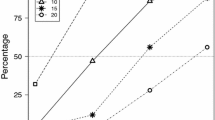Abstract
In this paper, we address the problem of how to extend a ranking over single objects to another ranking over all possible collections of objects, taking into account the fact that objects grouped together can have mutual interaction. An answer to this issue is provided using game theory and, specifically, the fact that an extension (i.e. a total preorder on the set of all subsets of objects) must be aligned with some probabilistic value, in the sense that the ranking of the objects (according to some probabilistic value computed on a numerical representation of the extension) must also preserve the primitive preorder on the singletons, no matter which utility function is used to represent the extension. We characterize families of aligned extensions, we focus on their geometric properties and we provide algorithms to verify their alignments. We also show that the framework introduced in this paper may be used to study a new class of extension problems, which integrate some features dealing with risk and complete uncertainty within the class of preference extension problems known in the literature with the name of sets as final outcomes.
Similar content being viewed by others
Notes
Observe: \(p_0=p^i(\emptyset )\) for all \(i\).
References
Banzhaf J III (1964) Weighted voting doesn’t work: a mathematical analysis. Rutgers Law Rev 19:317
Barberà S, Barrett C, Pattanaik P (1984) On some axioms for ranking sets of alternatives. J Econ Theory 33(2):301–308
Barberà S, Bossert W, Pattanaik P (2004) Ranking sets of objects. Handbook of Utility Theory: Extensions 2:893–977
Bossert W (1995) Preference extension rules for ranking sets of alternatives with a fixed cardinality. Theory Decis 39(3):301–317
Bossert W, Pattanaik PK, Xu Y (1994) Ranking opportunity sets: an axiomatic approach. J Econ Theory 63(2):326–345
Carreras F, Freixas J (1999) Some theoretical reasons for using (regular) semivalues. In: de Swart H (ed) Logic, game theory and social choice. Tilburg University Press pp 140–154
Carreras F, Freixas J (2000) A note on regular semivalues. Int Game Theory Rev 2(4):345–352
Carreras F, Freixas J (2008) On ordinal equivalence of power measures given by regular semivalues. Math Soc Sci 55(2):221–234
Dubey P, Neyman A, Weber R (1981) Value theory without efficiency. Math Oper Res 6(1):122–128
Fishburn P (1992) Signed orders and power set extensions. J Econ Theory 56(1):1–19
Freixas J (2010) On ordinal equivalence of the Shapley and Banzhaf values for cooperative games. Int J Game Theory 39(4):513–527
Gale D, Shapley L (1962) College admissions and the stability of marriage. Am Math Month 69(1):9–15
Geist C, Endriss U (2011) Automated search for impossibility theorems in social choice theory: ranking sets of objects. J Artif Intel Res 40:143–174
Gul F, Pesendorfer W (2001) Temptation and self-control. Econometrica 69(6):1403–1435
Hadar J, Russell WR (1969) Rules for ordering uncertain prospects. Am Econ Rev 59(1):25–34
Kannai Y, Peleg B (1984) A note on the extension of an order on a set to the power set. J Econ Theory 32(1):172–175
Kreps D (1979) A representation theorem for “preference for flexibility”. Econ J Econ Soc 47(3):565–577
Lucchetti R, Radrizzani P, Munarini E (2010) A new family of regular semivalues and applications. Int J Game Theory 40(4):1–21
Mas-Colell A, Whinston M, Green J (1995) Microeconomic theory, vol 1. Oxford University Press, New York
Moretti S, Patrone F (2008) Transversality of the Shapley value. Top 16(1):1–41
Moretti S, Tsoukias A (2012) Ranking sets of possibly interacting objects using Shapley extensions. In: Thirteenth International Conference on the Principles of Knowledge Representation and Reasoning (KR 2012). AAAI press pp 199–209
Nitzan S, Pattanaik P (1984) Median-based extensions of an ordering over a set to the power set: an axiomatic characterization. J Econ Theory 34(2):252–261
Owen G (1995) Game Theory, 3rd edn. Academic Press, San Diego
Puppe C (1996) An axiomatic approach to preference for freedom of choice. J Econ Theory 68(1):174–199
Roth A (1985) The college admissions problem is not equivalent to the marriage problem. J Econ Theory 36(2):277–288
Shapley L (1953) A value for n-person games. In: K. H. and T. A.W., (eds) Contributions to the Theory of Games II. Princeton University Press, Princeton, pp 307–317
Weber RJ (1988) Probabilistic values for games. In: Roth AE (ed) The Shapley Value. Essays in Honor of Lloyd S. Shapley. Cambridge University Press, Cambridge, pp 101–120
Author information
Authors and Affiliations
Corresponding author
Additional information
S. Moretti benefited from the support of the French National Research Agency (ANR) projects NETLEARN (Grant No. ANR-13-INFR-004) and AMANDE (Grant No. ANR-13-BS02-0004).
Appendix
Appendix
We provide the details of the calculations proving that the relation \(\succcurlyeq \) of Example 4 is \(\pi ^{\mathbf {p}}\)-aligned with all semivalues \(\pi ^{\mathbf {p}} \in \mathcal {S}\).
Fix a semivalue \(\pi ^{\mathbf {p}} \in \mathcal {S}\), and consider a numerical representation \(v \in V(\succcurlyeq )\). We have that
where the inequality follows from the fact that \(v(2,4)-v(1,4)>0\) for every semivalue \(\pi ^\mathbf {p}\) and every \(v \in V(\succcurlyeq )\). Note that, due to the relative ranking of coalitions, we have that
and
Moreover, we have that
where the strict inequality follows from relations (29) and (30). By relation (28), it immediately follows that \(\pi ^\mathbf {p}_2(v)-\pi ^\mathbf {p}_1(v)>0\) for every semivalue \(\pi ^\mathbf {p}\) and every \(v \in V(\succcurlyeq )\).
In a similar way, for every semivalue \(\pi ^\mathbf {p}\) and every \(v \in V(\succcurlyeq )\), we have immediately that
and that
Of course one can verify as well that the preorder fulfils the DPR property.
Rights and permissions
About this article
Cite this article
Lucchetti, R., Moretti, S. & Patrone, F. Ranking sets of interacting objects via semivalues. TOP 23, 567–590 (2015). https://doi.org/10.1007/s11750-014-0357-5
Received:
Accepted:
Published:
Issue Date:
DOI: https://doi.org/10.1007/s11750-014-0357-5




